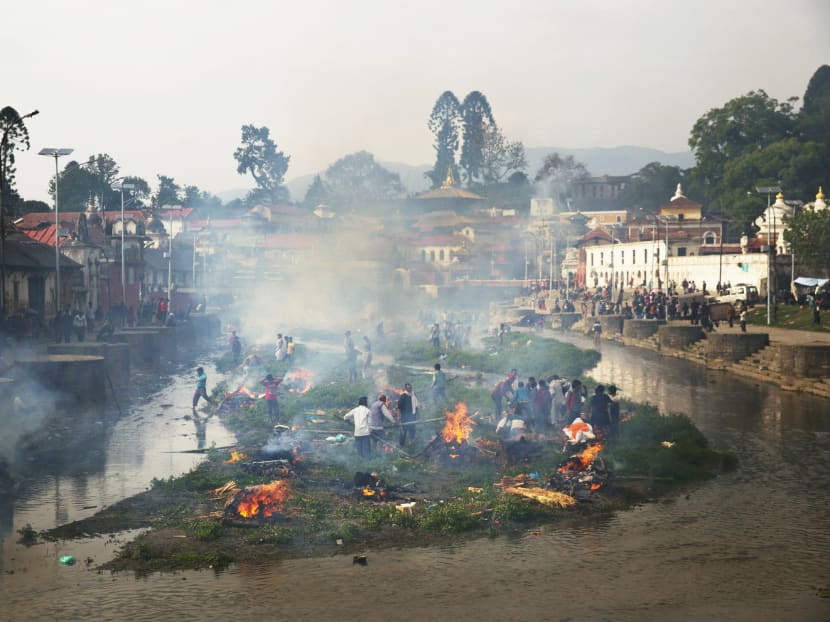Desperation in Nepal as food, supplies run low
KATHMANDU — Shelter, fuel, food, medicine, power, news and workers — Nepal’s earthquake-hit capital was short on everything yesterday as its people searched for lost loved ones, sorted through rubble for their belongings and struggled to provide for their families’ needs.

Flames rise from funeral pyres during the cremation of victims of Saturday’s earthquake at the Pashuputi Nath Temple on the banks of Bagmati River in Kathmandu on Sunday. Well over 1,000 of the victims were in Kathmandu, where an eerie calm prevailed yesterday. Photo: AP
KATHMANDU — Shelter, fuel, food, medicine, power, news and workers — Nepal’s earthquake-hit capital was short on everything yesterday as its people searched for lost loved ones, sorted through rubble for their belongings and struggled to provide for their families’ needs.
In much of the countryside, it was worse. With key expressways blocked by landslides, many villages and communities are without water and electricity, surviving on salvaged food, and with no outside help.
The death toll soared past 3,900, even without a full accounting from vulnerable mountain villages that rescue workers were still struggling to reach two days after the disaster.
While aid has begun arriving in the capital, including consignments of food, medical supplies, tents and sniffer dogs, the authorities are struggling to get relief out to devastated areas, overwhelmed by bad phone lines, poor roads, a lack of equipment and strong, repeated aftershocks.
Even getting aid and relief workers into Kathmandu is complicated, as the arrival of relief flights has caused major backups at the city’s small airport.
The Singapore Armed Forces’ (SAF) three C-130s transport planes carrying personnel from the Singapore Civil Defence Force, Singapore Police Force and SAF to support search and rescue as well as disaster relief efforts were diverted to other airports because of congestion at Kathmandu Tribhuvan International Airport, said Defence Minister Ng Eng Hen in a Facebook post yesterday.
“Ground commanders tell me that conditions at Kathmandu can be challenging. The airport is about 1,300m above sea level and weather conditions can change rapidly. Frustrating to all concerned, when so much help is needed.”
Four Indian air force aircraft carrying aid supplies and rescue personnel were also forced to return to New Delhi yesterday because of airport congestion, Indian Defence Ministry spokesperson Sitanshu Kar said.
Saturday’s magnitude 7.8 earthquake spread horror from Kathmandu to small villages and to the slopes of Mount Everest, triggering an avalanche that buried part of the base camp packed with climbers preparing to make their summit attempts.
Aid is coming from more than a dozen countries and many charities, but Mr Lila Mani Poudyal, the government’s Chief Secretary and the rescue coordinator, said Nepal needed more.
He said the recovery was also being slowed because many workers needed to clear debris — have “all gone to their families and are staying with them, refusing to work”.
“We are appealing for tents, dry goods, blankets, mattresses and 80 different medicines that the Health Department is seeking that we desperately need now,” Mr Poudyal told reporters. “We don’t have the helicopters that we need or the expertise to rescue the people trapped.”
As people are pulled from the wreckage, he noted, even more help is needed. “Now we especially need orthopaedic (doctors), nerve specialists, anaesthetists, surgeons and paramedics. We are appealing to foreign governments to send these specialised and smart teams.”
More than 7,100 people were injured in the quake, he said, estimating that tens of thousands of people had been left homeless.
Nepal police said in a statement that the country’s death toll had risen to 3,904 people. Another 61 people were killed in neighbouring India and China reported 20 dead in Tibet.
Well over 1,000 of the victims were in Kathmandu, the capital, where an eerie calm prevailed yesterday.
Kathmandu District Chief Administrator Ek Narayan Aryal said tents and water were being handed out yesterday at 10 locations in Kathmandu, but that aftershocks were leaving everyone jittery. The largest, on Sunday, was magnitude 6.7. “There have been nearly 100 earthquakes and aftershocks, which are making rescue work difficult. Even the rescuers are scared and running because of them.”
“We don’t feel safe at all. There have been so many aftershocks. It doesn’t stop,’’ said Rajendra Dhungana, 34, who spent Sunday with his niece’s family for her cremation at the Pashuputi Nath Temple.
The earthquake was the worst to hit the South Asian nation in more than 80 years. It was strong enough to be felt all across parts of India, Bangladesh, China’s region of Tibet and Pakistan. The quake has put a huge strain on the resources of this impoverished country best known for Everest, the highest mountain in the world. The economy of Nepal, a nation of 27.8 million people, relies heavily on tourism, principally trekking and Himalayan mountain climbing. AGENCIES






